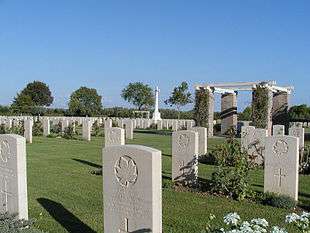Winter Line

The Winter Line was a series of German and Italian military fortifications in Italy, constructed during World War II by Organisation Todt and commanded by Albert Kesselring. The series of 3 lines was designed to defend a western section of Italy, focused around the town of Monte Cassino, through which ran the important Highway 6 which led uninterrupted to Rome. The primary Gustav Line ran across Italy from just north of where the Garigliano River flows into the Tyrrhenian Sea in the west, through the Apennine Mountains to the mouth of the Sangro River on the Adriatic coast in the east. The two subsidiary lines, the Bernhardt Line and the Hitler Line ran much shorter distances from the Tyrrehnian sea to just North East of Cassino where they would merge into the Gustav Line. Relative to the Gustav Line, the Hitler Line stood to the North-West and the Bernhardt Line to the South-East of the primary defenses.
The Gustav Line, though ultimately broken, effectively slowed the Allied advance for months between December 1943 and June 1944. Major battles in the assault on the Winter Line at Monte Cassino and Anzio alone resulted in 98,000 Allied casualties and 60,000 Axis casualties.[1][2]
Gustav Line
The center of the Gustav line crossed the main route north to Rome at strategically crucial Highway 6. It followed the Liri Valley and was anchored around the mountains behind the town of Cassino. Above it stood the ancient Benedictine sanctuary of Monte Cassino, which dominated the valley entrance, and Monte Cairo, which gave the defenders clear observation of potential attackers advancing towards the valley mouth. A bloody and protracted battle was waged over the monastery, known as the Battle of Monte Cassino. The north end of the line was held by the coastal town of Ortona, captured by Canadian forces in the fierce Battle of Ortona in December 1943 which became known as "the little Stalingrad".
Bernhardt and Hitler Lines
On the western side of the Apennines were two subsidiary lines, the Bernhardt Line in front of the main Gustav positions, and the Hitler Line some 8 kilometres (5 mi) to the rear. The Winter Line was fortified with gun pits, concrete bunkers, turreted machine-gun emplacements, barbed-wire and minefields. It was the strongest of the German defensive lines south of Rome. About 15 German divisions were employed in the defence. It took the Allies from mid-November 1943 to June 1944 to fight through all the various elements of the Winter Line, including the well-known battles at Monte Cassino and Anzio.
The offensive on the Bernhardt line was launched on December 1, 1943 as part of Operation Raincoat. British and American troops took the terrain around Monte Camino and the Mingano Gap within a week and a half of launching the assault but German operations persisted in the area for months.
Some authorities define the Bernhardt Line as crossing Italy from coast to coast following not just the western defensive positions described above but incorporating also the eastern defences of the Gustav Line. Other authorities use the Winter Line name interchangeably with the Gustav Line as defined above.
See also
References
Bibliography

- Fifth Army at the Winter Line 15 November 1943 - 15 January 1944. Washington: United States Army Center of Military History. 1945. CMH Pub 100-9.
- From the Volturno to the Winter Line 6 October-15 November 1943. Washington: United States Army Center of Military History. 1944. CMH Pub 100-8.
- Smith, Col. Kenneth V. (1944). WWII Campaigns, Naples-Foggia 9 September 1943-21 January 1944. Washington: United States Army Center of Military History. CMH Pub 72-17.
- Muhm, Gerhard. "German Tactics in the Italian Campaign".
- Muhm, Gerhard (1993). La Tattica tedesca nella Campagna d'Italia, in Linea Gotica avanposto dei Balcani, (Hrsg.) (in Italian). Roma: Amedeo Montemaggi - Edizioni Civitas,.
- Field Marshal Lord Carver (2001). The Imperial War Museum Book of the War in Italy 1943-1945. London: Sidgwick & Jackson. ISBN 0-330-48230-0.
- McNab, Chris (ed) (2014). Hitler’s Fortresses: German Fortifications and Defences 1939-45. Oxford, UK: Osprey Publishing. pp. 218–269 (Mountain Barriers– German Defensive Lines in Italy). ISBN 978-1-78200-828-6.
External links
| Wikimedia Commons has media related to Ortona War Cemetery. |
- Winter Line Stories Original stories from the front lines of the Italian Campaign by US Army Liaison Officer Major Ralph R. Hotchkiss
- Map of German defensive lines
- The Liri Valley: Canada’s Breakthrough to Rome
- Commonwealth War Graves Commission information on Moro River Cemetery
Multimedia
- CBC Archives CBC Radio reports from the Winter Line on May 14, 1944.